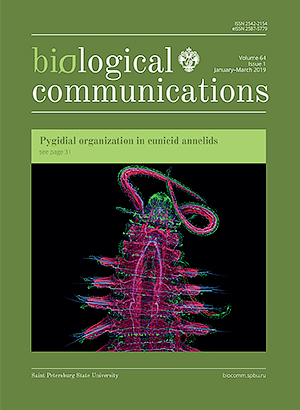Musculature and innervation of the pygidium in Eunicida (Annelida: Errantia)
DOI:
https://doi.org/10.21638/spbu03.2019.104Abstract
The pygidium is a terminal part of the annelid body that is considered non-homologous to body segments. Despite the high level of morphological diversity, the internal morphology of the pygidial region is very poorly studied. Recent research revealed that in some errant annelids the pygidium possesses complex musculature and innervation. To provide new data for the comparative analysis of pygidial organization, the musculature and innervation in the pygidial region in five annelid species belonging to the order Eunicida were studied using phalloidin labeling, immunohistochemistry and confocal scanning microscopy. In all studied species the pygidial musculature consists of a circular or horseshoe-shaped muscle. The pygidial innervation comprises two pairs of main longitudinal nerves and paired circumpigidial nerves. The single pair of longitudinal nerves in Ophryotrocha irinae may be regarded as a secondary loss. In Schistomeringos japonica a small terminal commissure between longitudinal nerves was found. The finding of numerous receptor cell endings in the surface of the pygidium suggests its important sensory function. Comparison with Phyllodocida demonstrates the high level of similarities in the pygidial organization and the loss of the terminal commissure in Eunicida.
Keywords:
Annelida, Eunicida, nervous system, musculature, confocal microscopy
Downloads
References
Downloads
Published
How to Cite
Issue
Section
License
Articles of Biological Communications are open access distributed under the terms of the License Agreement with Saint Petersburg State University, which permits to the authors unrestricted distribution and self-archiving free of charge.





